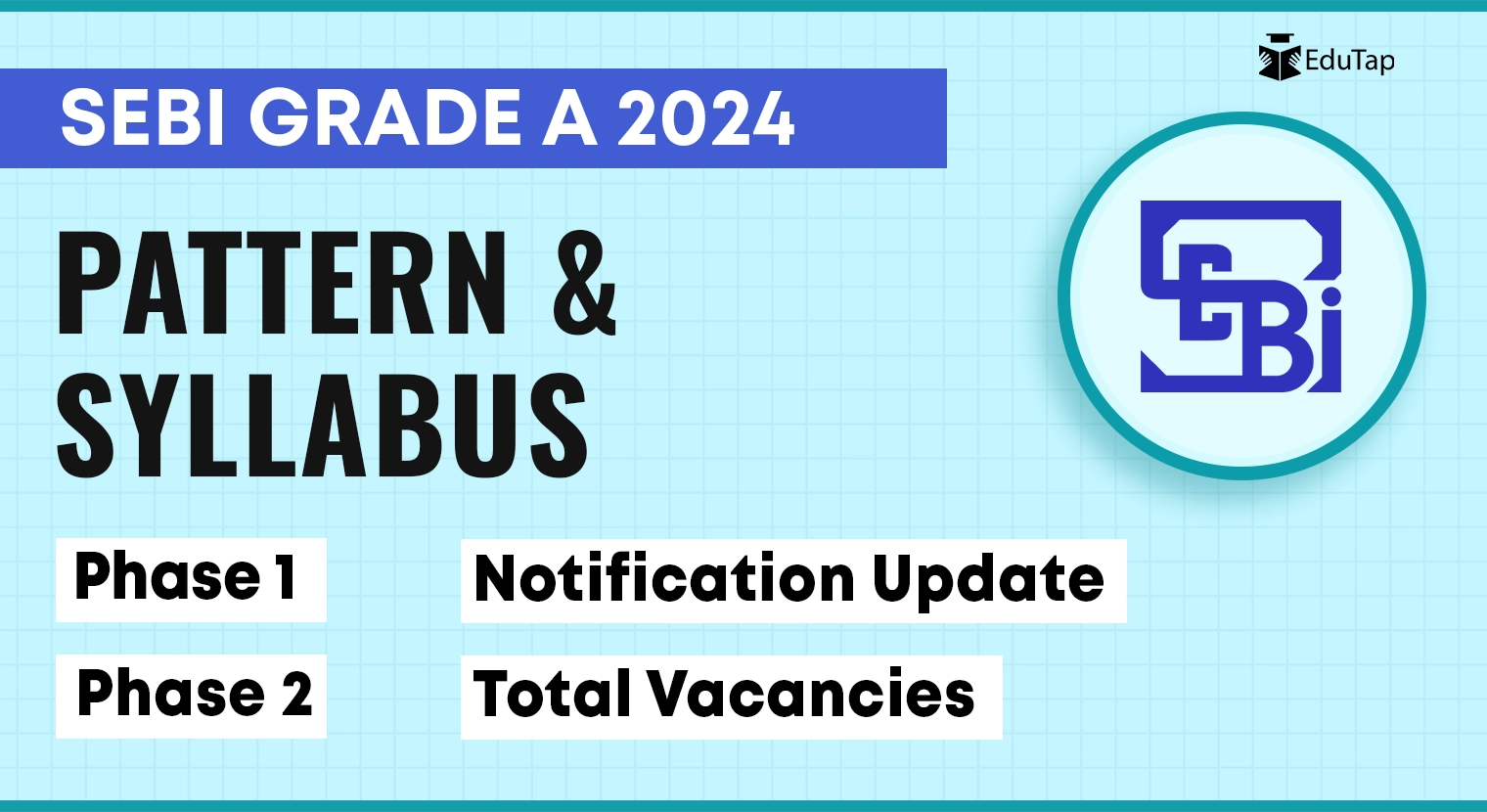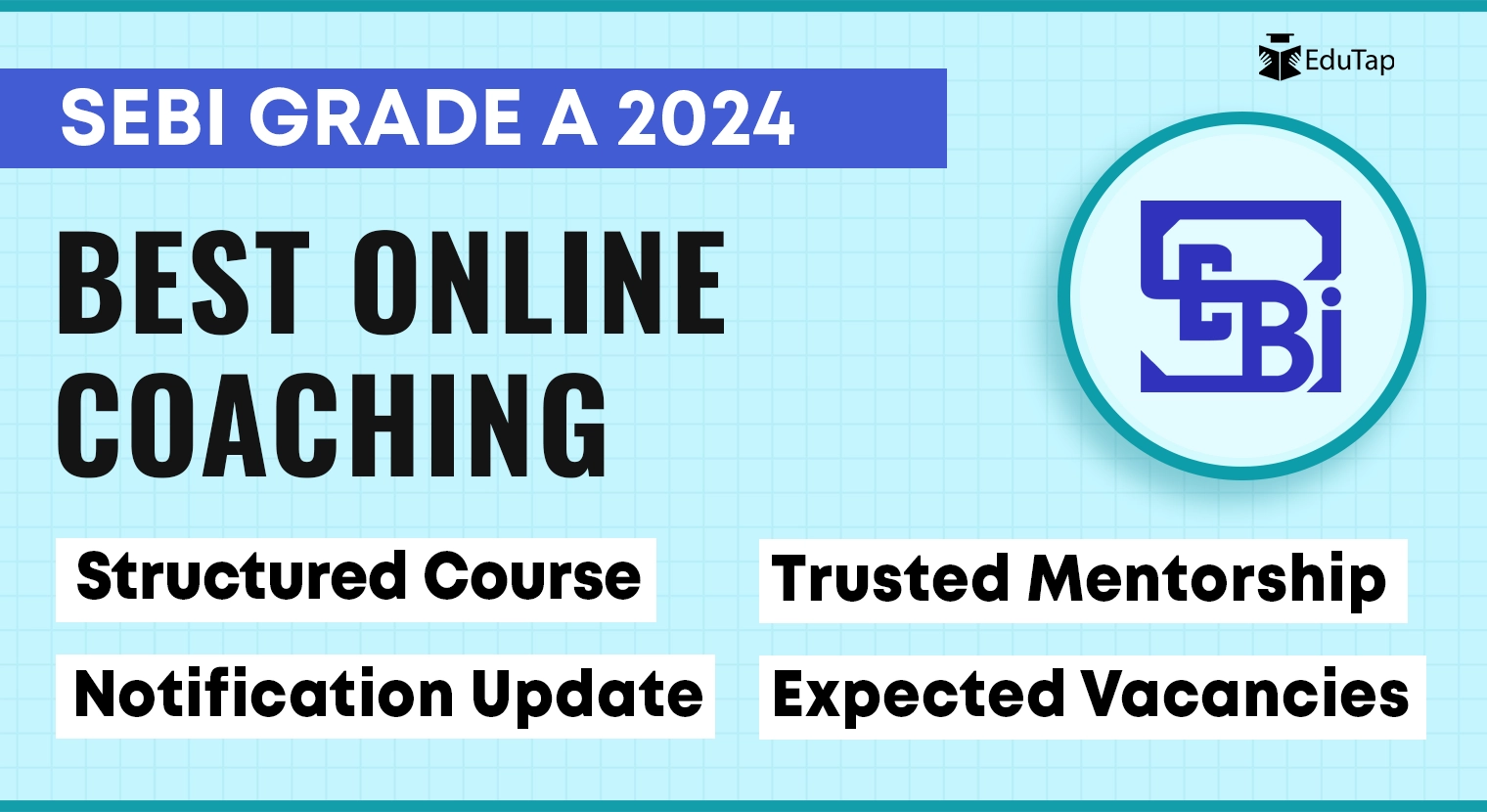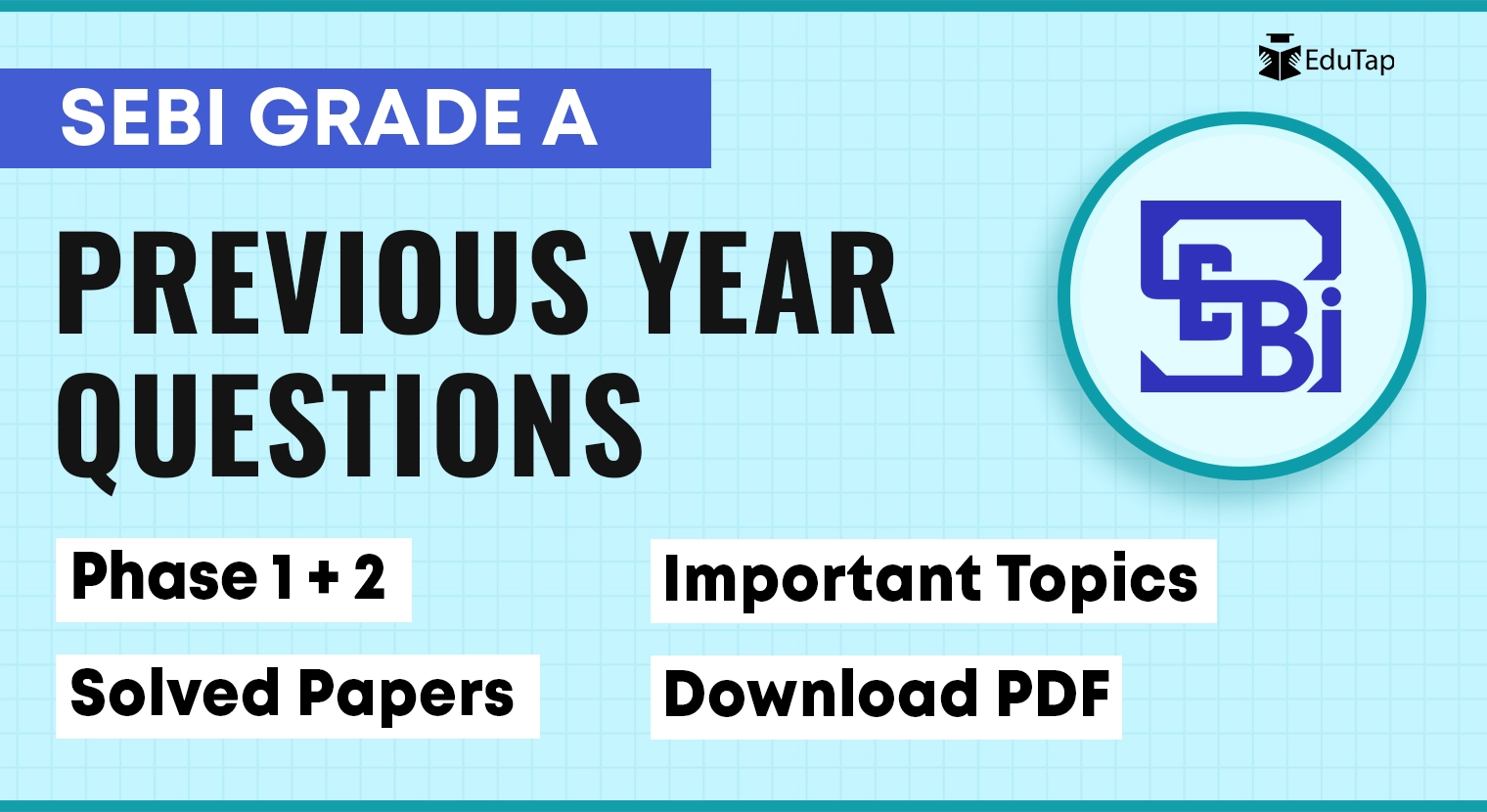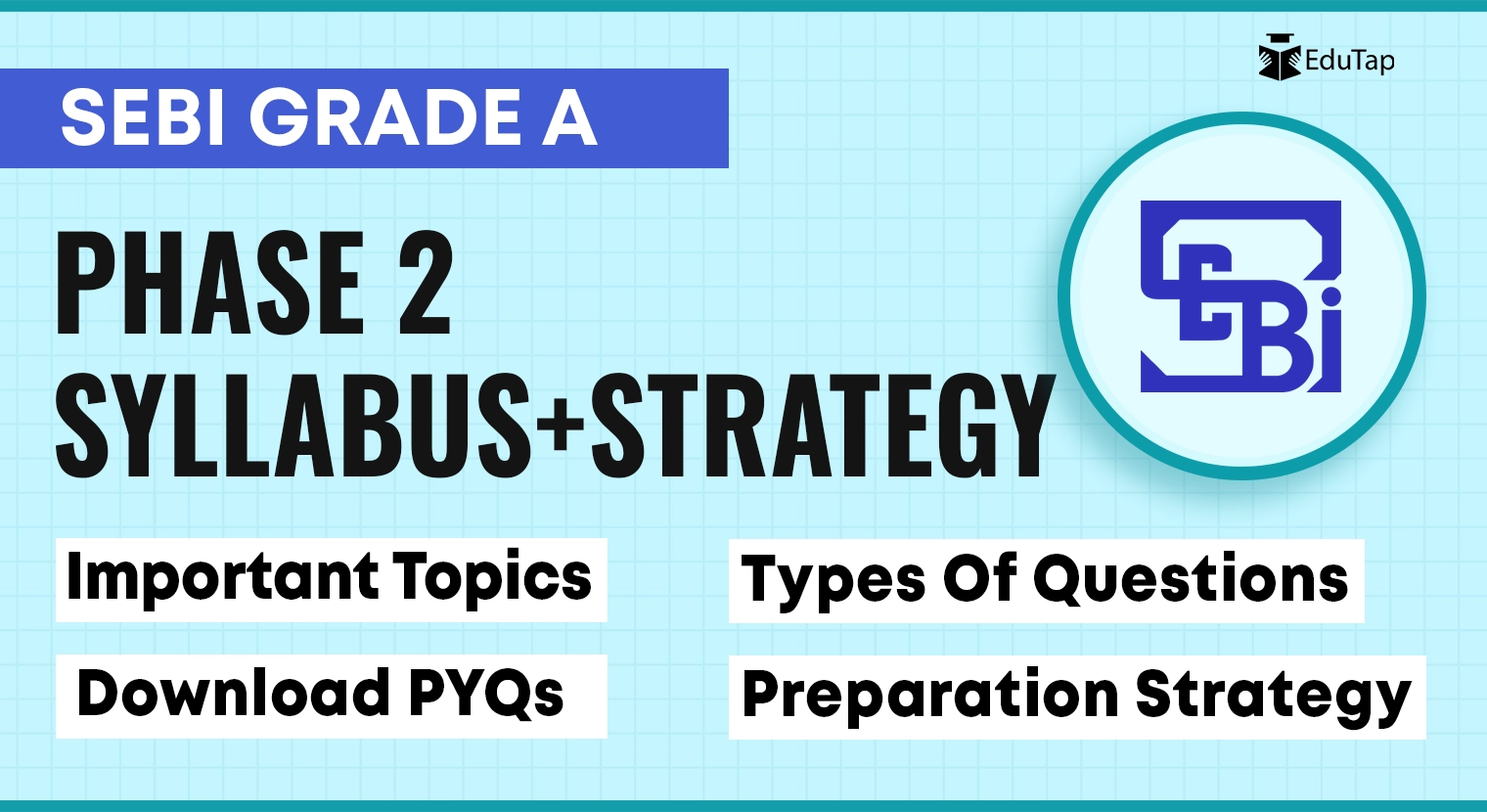Aspiring to become a SEBI Grade A officer in 2024? Understanding the examination pattern and syllabus is your first step towards dream career in this organisation.
In this blog, we’ll explain the SEBI Grade A 2024 exam pattern and syllabus in detail, helping you prepare effectively for the 2024 exam.
SEBI Grade A 2024 Exam Pattern
The SEBI Grade A exam is a 3-phase selection process. Each phase is designed to assess the different skills and knowledge required for the role.
- Phase 1 (Prelims)
- Phase 2 (Mains)
- Phase 3 (Interview)
SEBI Grade A Phase 1 Exam Pattern
The SEBI Grade A Phase 1 exam is an objective-type test that evaluates the candidate’s fundamental knowledge and understanding of various subjects. It is qualifying in nature and serves as a screening test to shortlist candidates for the next rounds of the examination. Phase 1 consists of 2 papers.
Phase 1 Paper 1
SEBI Grade A Phase 1 Paper 1 comprises 80 multiple-choice questions with a total of 100 marks and is to be completed within a 60-minute time frame. These questions are spread across four subjects (20 questions per subject), which include:
- General Awareness (Incorporating questions of easy to moderate difficulty level, particularly pertaining to the Financial Sector)
- English Language
- Quantitative Aptitude
- Test of Reasoning
For your easy understanding, we have provided the above-mentioned information in a table form below.
| SEBI Grade A Paper 1 (Phase 1) | |||
| SNo. | Section | No of Questions | Max Marks |
| 1 | General Awareness | 20 | 25 |
| 2 | English Language | 20 | 25 |
| 3 | Quantitative Aptitude | 20 | 25 |
| 4 | Reasoning | 20 | 25 |
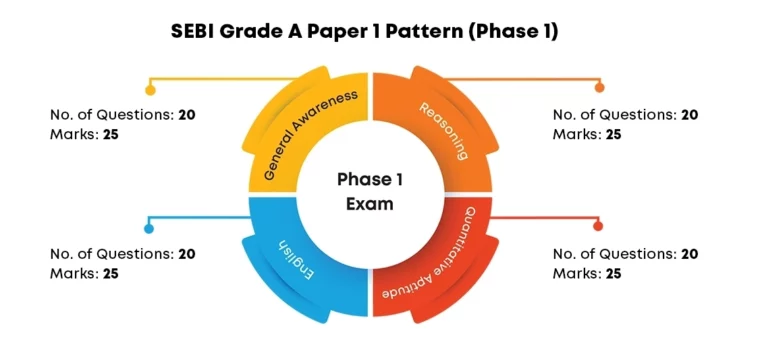
Phase 1 Paper 2
The SEBI Grade A Phase 1 Paper 2 for the general stream comprises 100 marks and 40 minutes are given to complete the paper. It includes 50 multiple-choice questions (2 marks each) covering a range of subjects, such as:
- Commerce
- Accountancy
- Management
- Finance
- Costing
- Companies Act
- Economics
For your easy understanding, we have provided the above-mentioned information in a table form below.
| SEBI Grade A Paper 2 (Phase 1) | |||
| SNo. | Section | No of Questions | Max Marks |
| 1 | Commerce | 50 questions covering these 7 sections | |
| 2 | Accountancy | ||
| 3 | Management | ||
| 4 | Finance | ||
| 5 | Costing | ||
| 6 | Companies Act | ||
| 7 | Economics | ||
| Total | 50 | 100 | |
Negative Marking
One-fourth of the marks are deducted for each wrong answer, which applies to both Paper 1 and Paper 2 in the SEBI Grade A Phase 1 exam. No marks are deducted if a candidate leaves a question blank on the OMR sheet.
Phase 1 Nature
SEBI Grade A Phase 1 exam is designed as a qualifying round, where the marks obtained are exclusively used for shortlisting candidates for Phase 2. These Phase 1 marks do not contribute to the final selection of candidates.
Cut-Off
Since SEBI Grade A Phase 1 is of a qualifying nature, fixed cut-offs are set for both Paper 1 and Paper 2. The cut-off for Paper 1 is a minimum of 30% i.e. 30 marks out of 100, while for Paper 2, it is a minimum of 40% i.e. 40 marks out of 100..
Candidates need to secure separate cut-offs in each paper as mentioned above as well as aggregate cut-off marks of 40% i.e. 80 marks out of 200 in the Phase 1 exam to be shortlisted for Phase 2.
For the SEBI Grade A phase 1 exam, no separate merit list is prepared according to the number of vacancies advertised and the calling ratio. All you have to do is score at least 30 marks in Paper 1, 40 marks in Paper 2, and a total of 80 or more marks in Paper 1+2 to be shortlisted for the Phase 2 exam.
Paper Language
Question papers for both Paper 1 and Paper 2 are available in both Hindi and English, except for the English language test. This bilingual approach ensures that candidates are comfortable with the language in which they are most proficient, promoting equal opportunity for all.
For your easy understanding, we have provided the detailed SEBI Grade A Phase 1 exam pattern information in a table form below.
| SEBI Grade A Phase 1 Exam Pattern | |||||
| SNo. | Paper | Stream/Subjects | Maximum Marks | Duration | Cut Off |
| 1 | Paper 1 | All Streams: Multiple choice questions on the subjects viz. General Awareness (including some questions related to the Financial Sector of easy to moderate difficulty level), English Language, Quantitative Aptitude, and Test of Reasoning. | 100 | 60 Minutes | 30% |
| 2 | Paper 2 | General Stream: Multiple choice questions on subjects Commerce, Accountancy, Management, Finance, Costing, Companies Act & Economics. | 100 | 40 Minutes | 40% |
| Legal, Information Technology & Official Language stream: Multiple choice questions on Specialized subjects related to the stream. | 100 | 40 Minutes | 40% | ||
| Research Stream: Multiple choice questions on subjects Economics, Econometrics, Statistics, Finance and Commerce. | |||||
| Aggregate Cut-Off | 40% | ||||

SEBI Grade A Phase 2 Exam Pattern
SEBI Grade A Phase 2 is the second stage of the selection process. Candidates shortlisted for Phase 2 receive new hall tickets specifically for this stage. For candidates who have applied in multiple streams, Paper 2 is conducted in various shifts, the timings of which are intimated in the hall ticket. Similar to the Phase 1 exam, the Phase 2 exam also consists of 2 papers.
Phase 2 Paper 1
SEBI Grade A Phase 2 Paper 1 comprises descriptive English questions with a total of 100 marks and is to be completed within a 60-minute time frame. It comprises three topics i.e., essay, precis, and reading comprehension.
For your easy understanding, we have provided the above-mentioned information in a table form below.
| SEBI Grade A Paper 1 (Phase 2) | ||||
| SNo. | Section | Topic | No of Questions | Max Marks |
| 1 | Descriptive English | Essay | You need to attempt 1 out of 4 questions | 100 |
| Precis | 1 | |||
| Reading Comprehension | 4-5 | |||
Phase 2 Paper 2
SEBI Grade A Phase 2 Paper 2 for the general stream comprises 100 marks and 40 minutes are given to complete the paper. It includes 50 multiple-choice questions (2 marks each) covering a range of subjects, such as
- Commerce
- Accountancy
- Management
- Finance
- Costing
- Companies Act
- Economics
| SEBI Grade A Paper 2 (Phase 2) | |||
| SNo. | Section | No of Questions | Max Marks |
| 1 | Commerce | 50 questions covering these 7 sections | |
| 2 | Accountancy | ||
| 3 | Management | ||
| 4 | Finance | ||
| 5 | Costing | ||
| 6 | Companies Act | ||
| 7 | Economics | ||
| Total | 50 | 100 | |
Negative Marking
One-fourth of the marks are deducted for each wrong answer, which applies to both Paper 1 and Paper 2 in the SEBI Grade A Phase 2 exam. No marks are deducted if a candidate leaves a question blank on the OMR sheet.
Cut-off
SEBI Grade A Phase 2 exam has specific minimum cut-off criteria. Candidates must score a minimum of 30% in Paper 1 i.e.30 marks out of 100 and a minimum of 40% i.e. 40 marks out of 100 in Paper 2. Furthermore, candidates need to secure aggregate cut-off marks of 50% i.e. 100 marks out of 200 in the Phase 2 exam to be shortlisted for Phase 3. The aggregate marks are calculated with the weightage of 1/3rd for Paper 1 and 2/3rd for Paper 2.
For e.g., if a candidate has appeared for both Paper 1 and Paper 2 of the SEBI Grade A Phase 2 exam and scored 90 and 60 marks, respectively. To calculate the aggregate marks:
- For Paper 1, you take 1/3rd of the marks, which is (1/3) * 90 = 30 marks.
- For Paper 2, you take 2/3rd of the marks, which is (2/3) * 60 = 40 marks.
- Now, add these weighted marks to get aggregate marks:
- 1/3rd marks of Paper 1 + 2/3rd marks of Paper 2, i.e. 70 marks out of 100.
This is how the aggregate marks are calculated by assigning different weightage to Paper 1 and Paper 2, with Paper 2 carrying more weight in the final score.
Paper Language
Question papers for both Paper 1 and Paper 2 are available in both Hindi and English, except for the English language test.
For your easy understanding, we have provided the detailed SEBI Grade A Phase 2 exam pattern information in a table form below.
| SEBI Grade A Phase 2 Pattern | ||||||
| SNo. | Paper | Stream/Subjects | Maximum Marks | Duration | Cut Off | Weightage |
| 1 | Paper 1 | All Streams: English (Descriptive Test) to test the drafting skills | 100 | 60 Minutes | 30% | 1/3rd |
| 2 | Paper 2 | General Stream: Multiple choice questions on subjects Commerce, Accountancy, Management, Finance, Costing, Companies Act and economics. | 100 | 40 Minutes | 40% | 2/3rd |
| Legal, Information Technology & Official Language stream: Multiple choice questions on Specialized subjects related to the stream. | 100 | 40 Minutes | 40% | 2/3rd | ||
| Research Stream: Multiple choice questions on subjects Economics, Econometrics, Statistics, Finance and Commerce. | ||||||
| Information Technology Stream: Coding Test (Languages: C++/ JAVA/Python) | 100 | 180 Minutes | 40% | 2/3rd | ||
| Aggregate Cut-Off | 50% | |||||
Important Note: Candidates who meet the specified criteria are shortlisted for Phase 3, which is the Interview round. Typically, the number of candidates shortlisted for Phase 3 is approximately three times the number of available vacancies. These candidates are shortlisted in order of merit.
SEBI Grade A Phase 3 (Interview) Pattern
The SEBI Grade A interview is the final stage of the selection process for candidates who have successfully cleared the Phase 1 and 2 examinations. Here is the SEBI Grade A Phase 3 pattern:
- Candidates are shortlisted for interview based on their Phase 2 marks only (aggregated sum of 2 papers)
- The weightage of marks obtained in Phase 2 is 85%, while marks obtained in the interview are given a weightage of 15%.
- Candidates can opt for an interview either in Hindi or English.
The final selection is based on the aggregate marks obtained in Phase 2 (Papers 1 and 2) and the interview.
To calculate the final aggregate marks, let’s take the same example of a student who has scored 70 marks out of 100 in SEBI Grade A Phase 2 Paper 2. Now, apply the Paper 2 Phase 2 weightage of 85% to this score, which is 85% of 70 equals 59.5 marks. In addition to Paper 2 Phase 2, let’s assume the student scores 6 marks during the interview, bringing the total to 59.5 + 6 = 65.5 marks.
So, the final aggregate marks for the students are 65.5.
Now that you have understood the SEBI Grade A officer pattern, let’s understand the exam syllabus.
SEBI Grade A Exam Syllabus
Understanding the SEBI Grade A exam syllabus significantly impacts the preparation strategy and success in the examination. Below is the detailed syllabus of SEBI Grade A Phases 1 and 2.
SEBI Grade A Phase 1 Syllabus
Here’s an overview of the syllabus for Phase 1 of the SEBI Grade A Examination.
Paper 1
Below, we have explained the Paper 1 syllabus of the SEBI Grade A Phase 1 exam:
1. General Awareness (GA)
GA is divided into 2 parts, static and current affairs. As per our analysis of previous year question papers, 2-3 questions are asked from the static part and 17-18 questions are from the current affairs part of GA. The following topics are most frequently asked from the general awareness section:
Current GA Syllabus for SEBI Grade A Phase 1 Exam
- National News: MoUs, summits and major events related to India.
- International: Summits and conferences held abroad.
- Financial & Economics News
- Financial Awareness: RBI and SEBI Notification and Regulations
- Defence: Military exercises, drills and major updates related to the defence sector of India
- Days in News: Major events or days, along with its date and theme
- Persons in News: Obituaries, appointments, retirements
- Sports: Major tournaments and its winners
- Science, Technology and Space
- Awards and honours
- Environment
- Banking, Economy related news
- Reports and Government Schemes
- Books and Authors
Static GA Syllabus for SEBI Grade A Phase 1 Exam
- Chief Ministers and Cabinet Ministers
- National Parks and Sanctuaries
- Airport Locations, Stadiums
- Organisations’ Headquarters
- Banks’ Headquarters and Taglines
- Power Plants in India
- Indian Dance Forms
- Countries Capitals and their Currencies
- Important Days
2. English Language
Here is the English Language syllabus for the SEBI Grade A Phase 1 exam:
- Grammar
- Error Spotting
- Sentence Improvement
- Comprehension Ability
- Comprehension passage
- Cloze test
- Rearrangement
- Para jumbles
- Double Fillers
- Vocabulary – Synonyms, Antonyms, One-word Substitution, Phrasal Verbs
3. Quantitative Aptitude
Here is the Quantitative Aptitude syllabus for the SEBI Grade A Phase 1:
- Ratio and Proportion
- Percentage
- Profit and Loss
- Simple and Compound Interest
- Questions on Average and Age
- Time and Work
- Pipes and Cistern
- Time and Distance
- Mixture and Alligation
- Questions on Series and Quadratic equation
- Mathematical Inequalities
- Number Series
- Data Interpretation
- Simplification/Approximation
- Quantity Comparisons
- Data Sufficiency
- Partnership
4. Reasoning Ability
Here is the Reasoning Ability syllabus for the SEBI Grade A Phase 1:
- Alphanumeric series
- Coding and Decoding
- Syllogism
- Direction Sense
- Inequality
- Ranking and Order
- Blood Relation
- Puzzles and Seating arrangement
- Input-Output
- Critical Reasoning
- Questions Based on Data Sufficiency
Paper 2
Below, we have explained the Paper 2 syllabus of the SEBI Grade A Phase 1 exam:
1. Commerce and Accountancy
Here is the Commerce and Accountancy syllabus for SEBI Grade A Phase 1:
- Accounting as a financial information system.
- Accounting Standards with specific reference to Accounting for Depreciation, Inventories, Revenue Recognition, Fixed Assets, Foreign Exchange Transactions, Investments.
- Cash Flow Statement, Fund flow statement, Financial statement analysis; Ratio analysis.
- Accounting for Share Capital Transactions including Bonus Shares and right Shares.
- Employees Stock Option and BuyBack of Securities.
- Preparation and Presentation of Company Final Accounts.
Important Note:
Some Commerce and Accountancy topics are not explicitly mentioned in the SEBI Grade A syllabus but are important from the exam point of view. These topics are:
- Introduction to Accountancy
- Theory Base of Accounting
- Recording Transaction Part 1
- Recording Transaction Part 2
- Trial Balance and Bills of Exchange
2. Management
Here is the Management syllabus for the SEBI Grade A Phase 1:
- Management: Its nature and scope; The Management Processes. Planning, Organization, Staffing, Directing, and Controlling.
- The Role of a Manager in an Organization. Leadership: The Tasks of a Leader.
- Leadership Styles: Leadership Theories; A successful Leader versus an effective Leader.
- Human Resource Development: Concept of HRD; Goals of HRD
- Motivation, Morale, and Incentives: Theories of Motivation; How Managers Motivate; Concept of Morale; Factors determining Morale; Role of Incentives in Building up Morale.
- Communication: Steps in the Communication Process; Communication Channels; Oral versus Written Communication; Verbal versus non-verbal Communication; upward, downward and lateral communication; Barriers to Communication, Role of Information Technology.
3. Finance
Here is the Finance syllabus for the SEBI Grade A Phase 1:
- Financial System: Role and Functions of Regulatory bodies in the Financial Sector.
- Financial Markets: Primary and Secondary Markets (Forex, Money, Bond, Equity, etc.), functions, instruments, and recent developments.
- General Topics
- Basics of Derivatives: Forward, Futures, and Swap
- Recent Developments in the Financial Sector
- Financial Inclusion- use of technology
- Alternate source of finance, private and social cost-benefit, Public-Private Partnership
- Direct and Indirect taxes;-Non-tax sources of Revenue, GST, Finance Commission, Fiscal Policy, Fiscal Responsibility and Budget Management Act(FRBM),
- Inflation:-Definition, trends, estimates, consequences, and remedies (control): WPI, CPI-components, and trends
4. Costing
Here is the Costing syllabus for the SEBI Grade A Phase 1:
- Overview of Cost and Management Accounting: Introduction to Cost and Management Accounting, Objectives and Scope of Cost and Management Accounting.
- Methods of Costing: Single Output/ Unit Costing, Job Costing, Batch Costing, Contract Costing, Process/ Operation Costing, and Costing of Service Sectors.
- Basics of Cost Control and Analysis- (a) Standard Costing, (b) Marginal Costing, (c) Budget, and Budgetary Control.
- Lean System and Innovation – Introduction to Lean System, Just-in-Time (JIT), Kaizen Costing, 5 Ss, Total Productive Maintenance (TPM), Cellular Manufacturing/ One-Piece Flow Production Systems, Six Sigma (SS), Introduction to Process Innovation and Business Process Re-engineering(BPR)
5. Companies Act
Here is the Companies Act syllabus for the SEBI Grade A Phase 1:
- The Companies Act, 2013- Specific reference to Chapter III, Chapter IV, Chapter VIII, Chapter X, Chapter XI, Chapter XII, and Chapter XXVII.
Important Note:
Some Companies Act topics are not explicitly mentioned in the SEBI Grade A syllabus but are important from the exam point of view. These topics are:
- Chapter IX Companies Act: Accounts of Company
- Chapter XIII Companies Act: Remuneration of Managerial Personnel
- Chapter I of Companies Act: Basics of Companies Act
6. Economics
Here is the Economics syllabus for the SEBI Grade A Phase 1:
- Demand and Supply, Market Structures, National Income: Concepts and Measurement, Classical Vs Keynesian Approach Determination of output and employment, Consumption Function, Investment Function, Multiplier and Accelerator, Demand and Supply for Money, IS-LM, Inflation and Phillips Curve, Business Cycles
- Balance of Payments, Foreign Exchange Markets, Inflation, Monetary and Fiscal Policy, Non-banking Financial Institutions.
SEBI Grade A Phase 2 Syllabus
Here’s an overview of the syllabus for Phase 2 of the SEBI Grade A examination:
Paper 1
Below, we have explained the Paper 1 syllabus of the SEBI Grade A Phase 1 exam:
1. English
The English paper evaluates the writing skills of candidates and their ability to express ideas and comprehend topics effectively. It includes precis writing, essay writing, and reading comprehension.
The essay topics encompass diverse areas such as Economy/Finance, Technology/Internet, Abstract concepts, and Social Issues. Additionally, precis passages are derived from prominent newspapers, and reading comprehension questions are based on provided paragraphs.
Paper 2
The syllabus of Paper 2 is the same for both Phase 1 and Phase 2. However, it is important to know that the difficulty level of Paper 2 is higher in Phase 2.
Now that you have understood the SEBI Grade A officer exam pattern and syllabus, let’s take a look at the SEBI Grade A notification 2024.
SEBI Grade A 2024 Notification & Vacancies
The SEBI Grade A 2024 notification was released on 14 March 2024. The detailed notification will be released on the official website of SEBI on 13 April 2024.
Additionally, 62 vacancies have been released for the General stream. Vacancies have also been intimated for Legal, IT, Engineering, Research, and Official language.
Important Update: SEBI has postponed the application window for all streams of the Officer Grade A position. The recruitment registration, initially set for April 13, 2024, has now been delayed. SEBI made this announcement on April 10, 2024, citing the General Elections as the reason for the postponement. However, SEBI will announce new dates soon. Keep checking the SEBI website for updates.

Conclusion
In this blog, we have explained the SEBI Grade A 2024 pattern and syllabus for Phases 1 and 2 along with the notification dates. Understanding the details of exam pattern and having a firm grasp of the syllabus is essential for crafting a well-informed and effective preparation strategy. With the right blend of knowledge, practice, and a strategic approach, students can crack the SEBI Grade A exam.
FAQs
Start by understanding the syllabus thoroughly and creating a study plan accordingly. Cover each topic comprehensively, refer to standard textbooks, practise previous year question papers, and attempt mock tests. Stay updated with current affairs and economic developments.
A candidate must not have exceeded the age of 30 years as on March 31, 2024 i.e., candidate must have been born on or after April 01, 1994.
No, opting for English does not confer any advantage over Hindi. SEBI provides candidates with the option to select either Hindi or English as their preferred medium of communication during the interview. The choice of language does not have any impact on your interview. SEBI evaluates candidates based on their knowledge and communication skills, regardless of whether they choose Hindi or English.
There is no fixed duration of the interview, but it is typically a short interview session where the panel assess your knowledge, skills, and suitability for the role.
